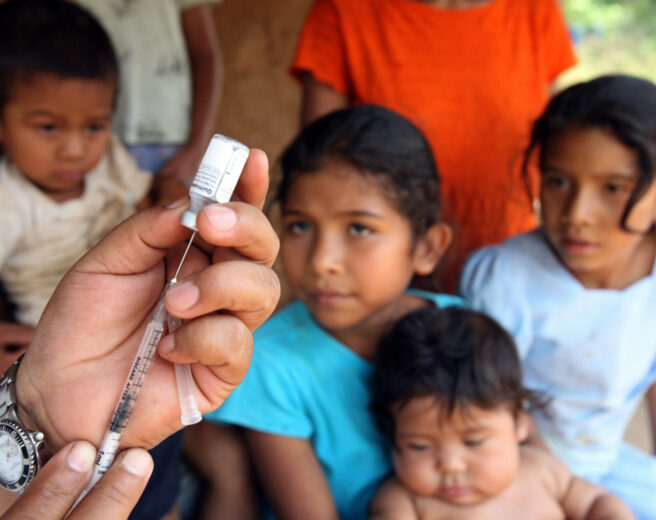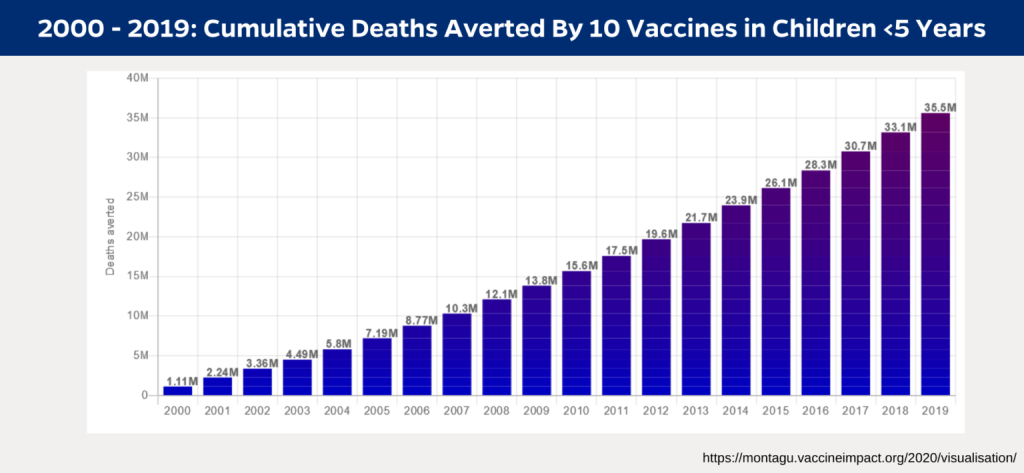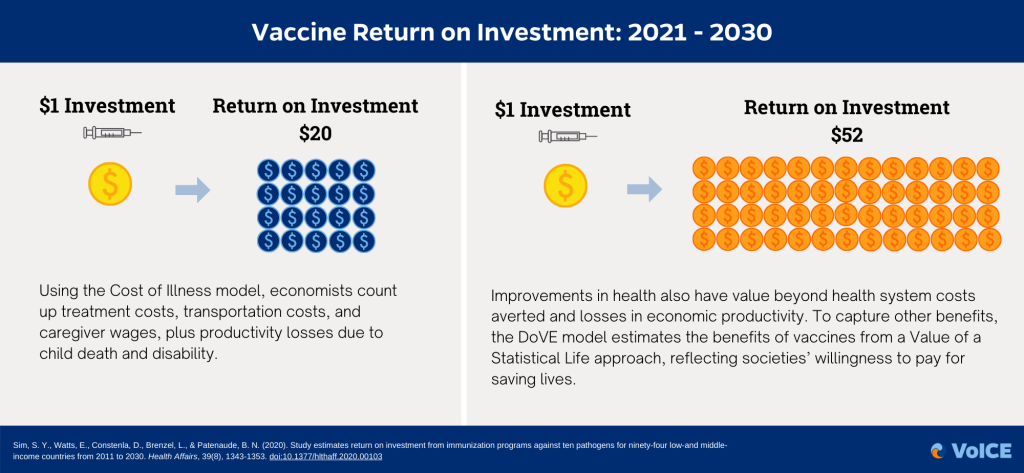
Vaccines provide incredible value in more ways than one. In addition to saving the lives of millions of children, vaccine programs also provide a high economic return on investment. New research demonstrates the incredible impact and value of vaccination for policymakers.
Key Messages
- The COVID-19 pandemic has disrupted routine immunization services across the globe. Maintaining pre-pandemic progress in routine immunization programs can save millions of lives and billions of dollars.
- Every US $1 invested in vaccine programs returned an estimated $20 in saved healthcare costs, lost wages, and lost productivity, according to new research from the Decade of Vaccine Economics (DoVE) Project.
- Using a Value of a Statistical Life approach to model the value of immunization, vaccine programs returned an estimated US $52 for every $1 invested.
- Between 2020 – 2030, vaccination programs against 10 pathogens in 98 countries are projected to save 32 million lives, the vast majority (28 million) will be children under 5 years old.
Sustaining Pre-Pandemic Immunization Projected to Save Millions of Lives
A comprehensive study of the impact of vaccination programs, published in The Lancet, estimates that vaccine programs targeting 10 diseases will have saved 69 million lives in 98 low- and middle-income countries (LMICs) between 2000 and 2030. With the COVID-19 pandemic disrupting routine immunization programs across the globe, this research highlights “what might be lost if current vaccination programs are not sustained.” This new analysis provides important evidence demonstrating the value of sustained investment in vaccination coverage, particularly in LMICs.
“In a time when the world desperately awaits a COVID-19 vaccine to help return our lives to normal, this study demonstrates how vaccines have transformed the health of the world, and given 36 million children another chance at life,” said lead study author, Dr. Xiang Li.
The 10 vaccine-preventable diseases included in the analysis were: hepatitis B, Haemophilus influenzae type b (Hib), human papillomavirus (HPV), Japanese encephalitis, measles, meningitis A (Neisseria meningitidis serogroup A), pneumococcal disease (Streptococcus pneumoniae), rotavirus, rubella, and yellow fever.
Key Findings: Lives Saved 2000 – 2019
- From 2000 through 2019, these 10 vaccines have saved 37 million lives across 98 countries. The vast majority of deaths prevented by these vaccines – 36 million – were children younger than 5 years old.
- Between 2000 and 2019 vaccination against these 10 common infectious diseases reduced deaths in children under 5 by nearly half (45%). That is, in the absence of vaccination, all-cause mortality among children younger than 5 years would be 45% higher than currently observed.
- Across 73 Gavi countries, 35 million deaths were averted between 2000 and 2019.
- Of the ten pathogens included in the analysis, vaccination against measles had the largest impact, with 33 million estimated deaths averted between 2000 – 2019: The equivalent to over 1.6 million deaths averted every year. The analysis projects that vaccination against measles will continue to save even more lives in the next decade (2020 – 2030) with an average of over 2.1 million deaths averted per year.

Maintaining Progress: Saving Lives in the Next Decade
Maintaining progress on immunization is essential to preventing millions of unnecessary deaths over the next 10 years, particularly in children under 5. The Lancet study, conducted by the Vaccine Impact Modelling Consortium, predicts that if pre-pandemic immunization progress is sustained over the next decade (2020 – 2030) that vaccines will continue to play a vital role in protecting children across the world, particularly those living in the world’s poorest communities.
- From 2020 – 2030, these 10 vaccines are projected to save 32 million lives across all ages and 28 million children under age 5.
- “A child born in 2019 will experience a massive reduction in their risk of dying from these 10 pathogens over their lifetime, with their mortality falling by 72% due to vaccination alone,” explained study author Dr. Katy Gaythorpe.
- The study also calculated disability-adjusted life years (DALYs) averted by vaccination. One DALY represents the loss of the equivalent of one year of full health. The study estimates that in the next decade (2020 – 2030) vaccines will avert 2.1 billion DALYs across all ages and 1.8 billion DALYs in children younger than 5 years old.
The Economic Benefits of Vaccine Programs far Outweigh Their Costs
Preventing illness through vaccination doesn’t just save lives, it also keeps people out of poverty and provides countries with a high economic return on investment. When children get sick, parents can be burdened with crippling financial costs. These costs can include medical care, transportation for treatment, and lost wages.
Investing in immunization programs in the world’s poorest countries yields a significant return on the initial investment. New research from the Decade of Vaccine Economics (DoVE) project, published in Health Affairs, measured the impact of immunization programs against ten pathogens (Haemophilus influenzae type b, hepatitis B, human papillomavirus, Japanese encephalitis, measles, Neisseria meningitidis serotype A, Streptococcus pneumoniae, rotavirus, rubella, and yellow fever) in 94 low- and middle-income countries from 2011 through 2030.
Understanding the DoVE Approach
This new DoVE study modeled the return on investment of immunization programs by using two analytical modeling approaches to capture different aspects of the economic benefits of immunization.
The Cost of Illness approach captures the observable impact of immunization programs on household costs, health care costs, and labor productivity.
The Value of a Statistical Life approach reflects the less tangible costs associated with societies’ willingness to pay for saving lives.
Key Findings: Vaccines are a Smart Investment
- The economic benefits of vaccine programs far outweigh their costs. With an investment of just a few dollars per child, vaccination can prevent life-threatening illnesses, life-long disability, and medical impoverishment for families.
- The analysis estimates that from 2011 to 2030 vaccine programs will generate a net benefit of billions of dollars in savings across countries: $1,445.3 billion using the Cost of Illness modeling approach and $3,371.5 billion with the Value of a Statistical Life approach.
- From 2021 to 2030, every US $1 invested in vaccine programs averted around $20 in healthcare costs, lost caregiver wages and missed work, and lost productivity.
- Assessing return on investment based on the value societies place on saving lives (a Value of a Statistical Life approach), vaccine programs returned about US $52 for every $1 spent from 2021 to 2030.
- For comparison, publicly traded American companies in the S&P 500 have returned an average of US $2.16 for every $1 invested after ten years.
- Across all countries and years included in the analysis, vaccination against measles accounted for the majority of economic benefits (76.4% using the Cost of Illness modeling approach and 58.5% using the Value of a Statistical Life approach modeling approach) generated by vaccine programs.

Visualizing Immunization Program Costing and Economic Burden
VIEW-hub, a map-based platform for visualizing data on vaccine use and impact, recently released a new interactive module on immunization economics.
The new module displays cost-of-illness and program costing information from recent DoVE publications in interactive maps and informative country profiles.
Want to find more evidence on the return on investment for vaccines? Brows the VoICE Compendium to find advocacy messaging and evidence summaries!
- The greatest cost savings from introducing new vaccines and increasing immunization coverage would occur in countries and regions with high disease burden and large populations.
- The interruption of disease outbreaks through vaccination can yield a significant return on investment.
- Vaccination programs such as those for Rotavirus have shown a significant short-term return on investment.
- Investing in immunization programs in the world’s poorest countries yields a significant return on the initial investment.

